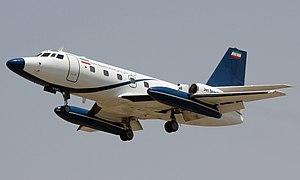Lockheed JetStar
| JetStar | |
|---|---|
 |
|
| An IRIAF JetStar in service with Government of Iran | |
| Role | Transport |
| National origin | United States |
| Manufacturer | Lockheed Corporation |
| First flight | 4 September 1957 |
| Retired | United States Air Force 1990s |
| Status | Active |
| Primary users |
Islamic Republic of Iran Air Force Mexican Air Force |
| Produced | 1957-1978 |
| Number built | 204 |
The Lockheed JetStar (company designations L-329 and L-1329; designated C-140 in USAF service) is a business jet produced from the early 1960s to the 1970s. The JetStar was the first dedicated business jet to enter service. It was also one of the largest aircraft in the class for many years, seating ten plus two crew. It is distinguishable from other small jets by its four engines, mounted on the rear of the fuselage, and the "slipper"-style fuel tanks fixed to the wings.
The JetStar originated as a private project within Lockheed, with an eye to winning a USAF requirement that was later dropped due to budget cuts. Lockheed decided to continue the project on its own for the business market.
The first two prototypes were equipped with two Bristol Siddeley Orpheus engines, the first of these, N329J, flying on 4 September 1957. The second of these was also equipped with the wing-mounted "slipper tanks", which was originally to be an option. Lockheed attempted to arrange a contract to produce the Orpheus in the US, but when these negotiations failed it re-engined the second prototype, N329K, with four Pratt & Whitney JT12s in 1959. The slipper tanks were removed and placed on the first prototype, N329J. N329J served as Kelly Johnson's personal transport for some time. The JT12 fit proved successful and was selected for the production versions, the first of which flew in mid 1960. These versions entered commercial service in 1961.
Sixteen JetStars were produced for the United States Air Force. Five C-140As were flight inspection aircraft for the Air Force Communications Service and were used to perform airborne testing of airport navigational aids from 1962 onwards. They began service during the Vietnam War and remained in service until the early 1990s. The "Flight Check" C-140As were combat-coded aircraft that could be distinguished from the VIP transport version by their distinctive paint scheme. The last C-140A to be retired was placed on static display at Scott AFB, Illinois.
An additional 11 airframes were designated C-140B, although the first of these predated the C-140As when it was delivered in 1961. The C-140Bs were used to transport personnel by the Military Airlift Command. Six of the aircraft were operated as VIP transports by the 89th Military Airlift Wing at Andrews Air Force Base. These VIP aircraft were designated as VC-140Bs. Members of the VIP transport fleet occasionally served as Air Force One during the 1970s and 1980s. Several other countries, such as Germany and Canada, have used military JetStars as transports for their heads of state, heads of government, and other VIPs.
...
Wikipedia
